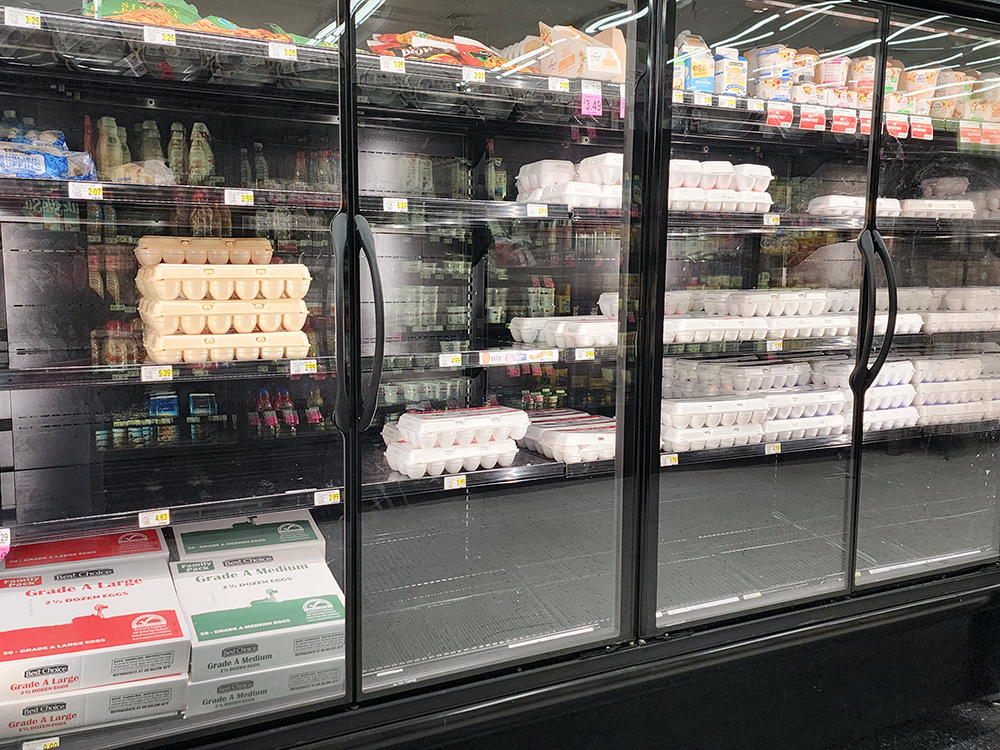There has been a lot of talk about eggs lately. I can’t tell you how many egg memes I’ve seen, with people attempting to make light of pocketbook pangs from purchasing this kitchen staple. Friends out west are paying more than $7 a dozen, and down south I’m hearing reports of 18-packs costing around $11. So what’s the deal? I did some digging to try and help crack the case (yes, I went there) on egg prices.
I needed to pick up a few things, eggs included, so I stopped at the nearest Superlo last Monday. The shelves were much more bare than usual, with none of the fancy cage-free/organic options available at all. A few stacks of Best Choice regular ol’ eggs were on offer, ranging from about $3.99 to $5.99, depending on size and color (don’t ask why brown eggs are higher — or why some eggs are brown to begin with; those are questions to explore another day). So, okay, something is going on here — but what?
The U.S. Department of Labor (DOL) listed the December 2022 national average for a dozen eggs at $4.25. For comparison, that number was $3.59 the previous month, and $1.79 a year ago. On January 12th, the DOL released its current Consumer Price Index, showing increases and decreases (mostly the former, sadly) in various spending categories. According to the release, “The index for meats, poultry, fish, and eggs increased 1.0 percent in December [from November], as the index for eggs rose 11.1 percent.” A closer look at the report shows that items in the “food at home” category rose 11.8 percent from December 2021 to December 2022. Under that umbrella, several groupings saw significant year-over-year increases — cereals and bakery products (16.1 percent); meats, poultry, fish, and eggs (7.7 percent); and dairy and related products (15.1 percent) among them. Ouch.
Alright, we know inflation has hit a number of industries, but what else? One major factor is the 2022 avian flu outbreak, which to date has affected nearly 60 million chickens in 47 states, exceeding the 50.5 million birds in 21 states that were affected by the 2015 outbreak, according to the Centers for Disease Control and Prevention (CDC), that caused egg prices to soar to a then-record-high of $2.96/dozen in September of that year. The CDC data shows that from September to December 2022, more than 150,000 chickens were affected in Tennessee facilities alone.
In an email response, Dale Barnett, executive director of the Tennessee Poultry Association, says that beyond the effects of bird flu, inflation, and “lingering supply chain challenges due to Covid,” there’s another component: “The exorbitant costs associated with the ongoing conversion to cage-free egg production systems (to meet the near-future goals and requirements of an increasing number of major grocers and restaurant chains) has been substantial.”
Barnett directed me to an editorial by Terrence O’Keefe in Egg Industry magazine for further clarification. O’Keefe writes that “10 U.S. states have passed legislation mandating sales of cage-free eggs, either now or at some future date.” Tennessee is not included among them at present. He continues, “The two largest grocers in the U.S., Walmart and Kroger, each backed away from prior 100 percent cage-free egg purchase pledges in the summer of 2022. This means cage-produced eggs will be available at retail in many U.S. states for several years. … Who an egg producer sells to and what states the customer does business in will determine whether a farm will go cage-free or keep its cages.”
The U.S. Department of Agriculture’s recent Egg Markets Overview states that current cage-free commitments require “66.7 billion cage-free eggs per year to meet 100 percent of needs from an approximate cage-free flock of 221.4 million hens … indicating a shortage of 133.4 million hens.”
As you can see, there’s much ado in the egg world (way more than I’ve been able to lay — heh — out here). There’s no clear timeline for when we’ll see things balance out, but one thing’s for sure: If the chicken comes before the egg, we’re going to need a lot more chickens.
